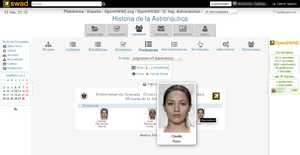SWAD (software)
 | |
|
SWAD LMS | |
| Original author(s) | SWAD development team |
|---|---|
| Developer(s) | SWAD development team |
| Stable release |
16.232.3
/ June 1, 2017[1] |
| Written in | C, C++ |
| Operating system | Linux server |
| Type | Course management system |
| License | AGPLv3[1] |
| Website | OpenSWAD.org |
SWAD (originally stood for "Sistema Web de Apoyo a la Docencia" in Spanish or "Web System for Education Support", currently stands for "Shared Workspace At a Distance") is a web application to manage the courses, students and teachers of one or more educational institutions.
History
The first version of SWAD appeared in September 1999. In 2005 its use was extended to the University of Granada.[2] The application was released as free software in January 2010[3][4] under Affero General Public License, version 3.[1][5] In 2010 the system was used by 1,100 professors and 35,000 students.[4] In 2011 it was used by 2,000 professors and 60,000 students in 2,800 courses.[6][7][8]
SWAD is currently available in 9 languages and used in the University of Granada[9][10][11][12][13] and the portal OpenSWAD.org. In February 2016 SWAD installation at the University of Granada housed 419 degrees (including undergraduate and graduate) with 7114 courses, 110057 students and 3304 teachers.[14]
Technical specifications
Server
SWAD core is a CGI programmed in C[15] comprising almost all the functionality of the platform. The core is supplemented with some external programs like photo processing module and chat module.[16]
The server runs on a Linux system with Apache and a MySQL or MariaDB database.
Clients
Being a web application, the client can be any modern web browser. To use the chat you must have Java runtime environment.
Besides the web client, there is an M-learning application for Android devices called SWADroid,[6][7] which implements some of the most used features in the web version.
Hierarchy and roles
Hierarchical organization
SWAD can accommodate in a single platform one or multiple educational organizations. It uses the following hierarchical structure:
- Countries
- Institutions (universities, academies, organizations, companies,...)
- Centres (faculties, buildings,...)
- Degrees (degrees, masters,...)
- Courses
- Group types (lectures, practicals, seminars,...)
- Groups (A, B, morning, afternoon,...)
The central element of this hierarchy is the course, which can register several teachers and students.
Roles
Each user has a role of student, non-editing teacher or teacher at each of the course in which he/she is enrolled. In addition, some users may be administrators of one or more degrees, centres or institutions, as well as global administrators of the platform.
See also
- Virtual Learning Environment
- Learning Management System
- ATutor
- Chamilo
- Claroline
- ILIAS
- Moodle
- Sakai Project
References
- 1 2 3 "SWAD download". OpenSWAD.org.
- ↑ "Web para prácticas de economía". Universia (in Spanish). Universia España. 2006-05-30.
- ↑ "SWAD, liberado" [SWAD, released]. http://osl.ugr.es/ (in Spanish). Oficina de Software Libre de la Universidad de Granada. 2010-01-21. External link in
|work=(help) - 1 2 "La Universidad de Granada libera su Sistema Web de Apoyo a la Docencia (SWAD)". Profesionales Digitales (in Spanish). 2010-04-12.
- ↑ "Liberada la plataforma SWAD bajo licencia AGPL v3" [Platform SWAD released under AGPL v3 license]. http://barrapunto.com/ (in Spanish). Barrapunto. 2010-01-21. External link in
|work=(help) - 1 2 "Los sistemas de apoyo informático a la docencia se deslocalizan". Profesionales Digitales (in Spanish). 2011-06-22.
- 1 2 "Los sistemas de apoyo informático a la docencia se deslocalizan". Universia (in Spanish). Universia España. 2011-06-23.
- ↑ G. Parra, Andrea (2011-12-11). "Formación universitaria sin pisar la clase". miUGR.es Canal universitario de Ideal.es (in Spanish). Ideal Comunicación Digital.
- ↑ López Morales, Manuel; Celma Vicente, Matilde; Cano-Caballero Gálvez, M. Dolores; Quero Rufián, Aurora; Rodríguez López, M. Ascensión (2011). "Docencia universitaria semipresencial. Experiencia en el uso de la plataforma virtual SWAD" [Semi-presential university teaching. An experience in the use of SWAD virtual platform] (PDF). Educación Médica (in Spanish). 14 (4): 229–234. Archived (PDF) from the original on 2012-03-22.
- ↑ Correa Rodríguez, M.; Cambil Martín, Jacobo (2011). "Estudio docente del Sistema Web de Apoyo a la Docencia en alumnado del Máster de Educación Secundaria" (PDF). Revista Scientia (in Spanish). 16 (2): 95–107. ISSN 1989-7375. Archived from the original on 2011-07-23.
- ↑ Cañas Vargas, Antonio; Ocaña Lara, Francisco A. (2010). "SWAD en los estudios de Farmacia" [SWAD in the studies in Pharmacy] (PDF). ARS Pharmaceutica (in Spanish). 51 (2): 1–17. ISSN 0004-2927. Archived from the original on 2011-07-23.
- ↑ Salicetti Fonseca, Alejandro; Romero Cerezo, Cipriano (2010). "La plataforma de apoyo a la docencia como opción metodológica para el aprendizaje de competencias" [The Support Platform for Educators as a Methodological Option for Competitive Learning] (PDF). Revista Educación (in Spanish). Universidad de Costa Rica. 34 (1): 83–100. ISSN 0379-7082. Archived from the original on 2011-07-28.
- ↑ Bueno Ibáñez, T.A.; Cámara Martos, F.; López Andújar, G. (2009). Pujol Cubells, Montserrat, ed. "Implantación de la Plataforma de Apoyo a la Docencia en la Facultad de Farmacia de Granada" (PDF). Edusfarm, revista d’educació superior en Farmàcia (in Spanish). Facultat de Farmàcia de la Universitat de Barcelona, Grup de Dinamització Pedagògica. 5. ISSN 1886-6271. Archived (PDF) from the original on 2011-07-24.
- ↑ "Estadísticas de uso en la UGR" [Usage statistics at the UGR] (in Spanish). Virtual Learning Center of the University of Granada. 2016-02-01.
- ↑ "Main core for SWAD platform (GitHub)". GitHub, Inc.
- ↑ "SWAD source code". OpenSWAD.org.
